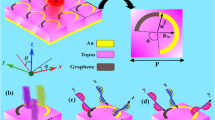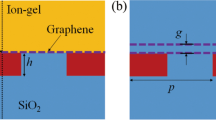Abstract
The potential of graphene for photonic applications was evidenced by recent demonstrations of modulators, polarization rotators and isolators. These promising yet preliminary results raise crucial questions: what is the optimal performance achievable by more complex designs and how can this optimum be achieved in practice? We answer by first demonstrating that the relevant figures of merit for the devices above are subject to absolute theoretical upper bounds. Strikingly, these limits are related only to the conductivity tensor of graphene; thus, we can provide essential roadmap information such as the best possible device performance versus wavelength and graphene quality. Second, based on the theory developed, physical insight and detailed simulations, we demonstrate how structures closely approaching these fundamental limits can be designed, demonstrating the possibility of significant improvement. These results are believed to be of paramount importance for the design of modulators, rotators and isolators using graphene or other two-dimensional materials.
This is a preview of subscription content, access via your institution
Access options
Subscribe to this journal
Receive 12 print issues and online access
$209.00 per year
only $17.42 per issue
Buy this article
- Purchase on Springer Link
- Instant access to full article PDF
Prices may be subject to local taxes which are calculated during checkout






Similar content being viewed by others
References
Geim, A. K. & Novoselov, K. S. The rise of graphene. Nature Mater. 6, 183–191 (2007).
Grigorenko, A. N., Polini, M. & Novoselov, K. S. Graphene plasmonics. Nature Photon. 6, 749–758 (2012).
Bonaccorso, F., Sun, Z., Hasan, T. & Ferrari, A. C. Graphene photonics and optoelectronics. Nature Photon. 4, 611–622 (2010).
Tassin, P., Koschny, T., Kafesaki, M. & Soukoulis, C. M. A comparison of graphene, superconductors and metals as conductors for metamaterials and plasmonics. Nature Photon. 6, 259–264 (2012).
Liu, M. et al. A graphene-based broadband optical modulator. Nature 474, 64–67 (2011).
Freitag, M., Low, T., Xia, F. & Avouris, P. Photoconductivity of biased graphene. Nature Photon. 7, 53–59 (2013).
Yan, H. et al. Damping pathways of mid-infrared plasmons in graphene nanostructures. Nature Photon. 7, 394–399 (2013).
Vakil, A. & Engheta, N. Transformation optics using graphene. Science 332, 1291–1294 (2011).
Tamagnone, M., Gomez-Diaz, J. S., Mosig, J. R. & Perruisseau-Carrier, J. Reconfigurable terahertz plasmonic antenna concept using a graphene stack. Appl. Phys. Lett. 101, 214102 (2012).
Perruisseau-Carrier, J. Graphene for Antenna Applications: Opportunities and Challenges from Microwaves to THz. Paper presented at LAPC2012, Loughborough (IEEE, 2012).
Filter, R. et al. Tunable graphene antennas for selective enhancement of THz-emission. Opt. Express 21, 3737–3745 (2013).
Rana, F., Strait, J. H., Wang, H. & Manolatou, C. Ultrafast carrier recombination and generation rates for plasmon emission and absorption in graphene. Phys. Rev. B 84, 045437 (2011).
Yao, Y. et al. Broad electrical tuning of graphene-loaded plasmonic antennas. Nano Lett. 13, 1257–1264 (2013).
Li, Z. & Yu, N. Modulation of mid-infrared light using graphene–metal plasmonic antennas. Appl. Phys. Lett. 102, 131108 (2013).
Pai-Yen, C., Argyropoulos, C. & Alu, A. Terahertz antenna phase shifters using integrally-gated graphene transmission-lines. IEEE Trans. Ant. Propag. 61, 1528–1537 (2013).
Sensale-Rodriguez, B. et al. Broadband graphene terahertz modulators enabled by intraband transitions. Nature Commun. 3, 780 (2012).
Liu, M., Yin, X. & Zhang, X. Double-layer graphene optical modulator. Nano Lett. 12, 1482–1485 (2012).
Sensale-Rodriguez, B. et al. Terahertz imaging employing graphene modulator arrays. Opt. Express 21, 2324–2330 (2013).
Gómez-Díaz, J. S. & Perruisseau-Carrier, J. Graphene-based plasmonic switches at near infrared frequencies. Opt. Express 21, 15490–15504 (2013).
Koester, S. J. & Li, M. High-speed waveguide-coupled graphene-on-graphene optical modulators. Appl. Phys. Lett. 100, 171107 (2012).
Lee, S. H. et al. Switching terahertz waves with gate-controlled active graphene metamaterials. Nature Mater. 11, 936–941 (2012).
Fallahi, A. & Perruisseau-Carrier, J. Design of tunable biperiodic graphene metasurfaces. Phys. Rev. B 86, 195408 (2012).
Amin, M., Farhat, M. & Baǧcı, H. A dynamically reconfigurable Fano metamaterial through graphene tuning for switching and sensing applications. Sci. Rep. 3, 2105 (2013).
Crassee, I. et al. Intrinsic terahertz plasmons and magnetoplasmons in large scale monolayer graphene. Nano Lett. 12, 2470–2474 (2012).
Fallahi, A. & Perruisseau-Carrier, J. Manipulation of giant Faraday rotation in graphene metasurfaces. Appl. Phys. Lett. 101, 231605 (2012).
Shimano, R. et al. Quantum Faraday and Kerr rotations in graphene. Nature Commun. 4, 1841 (2013).
Sounas, D. L. & Caloz, C. in IEEE International Symposium on Antennas and Propagation (APSURSI), 1597–1600 (IEEE, 2011).
Sounas, D. L. et al. Faraday rotation in magnetically biased graphene at microwave frequencies. Appl. Phys. Lett. 102, 191901 (2013).
Ubrig, N. et al. Fabry–Perot enhanced Faraday rotation in graphene. Opt. Express 21, 24736–24741 (2013).
Da, H. & Qiu, C.-W. Graphene-based photonic crystal to steer giant Faraday rotation. Appl. Phys. Lett. 100, 241106 (2012).
Andryieuski, A. & Lavrinenko, A. V. Graphene metamaterials based tunable terahertz absorber: effective surface conductivity approach. Opt. Express 21, 9144–9155 (2013).
Zhu, W., Rukhlenko, I. D. & Premaratne, M. Graphene metamaterial for optical reflection modulation. Appl. Phys. Lett. 102, 241914 (2013).
Lu, Z. & Zhao, W. Nanoscale electro-optic modulators based on graphene-slot waveguides. J. Opt. Soc. Am. B 29, 1490–1496 (2012).
Xu, C., Jin, Y., Yang, L., Yang, J. & Jiang, X. Characteristics of electro-refractive modulating based on graphene–oxide–silicon waveguide. Opt. Express 20, 22398–22405 (2012).
Lee, S., Lee, K., Liu, C.-H., Kulkarni, G. S. & Zhong, Z. Flexible and transparent all-graphene circuits for quaternary digital modulations. Nature Commun. 3, 1018 (2012).
Collin, R. E. Field Theory of Guided Waves (IEEE, 1991).
Gusynin, V. P., Sharapov, S. G. & Carbotte, J. P. Magneto-optical conductivity in graphene. J. Phys. Condens. Matter 19, 026222 (2007).
Kuzmenko, A. B., van Heumen, E., Carbone, F. & van der Marel, D. Universal optical conductance of graphite. Phys. Rev. Lett. 100, 117401 (2008).
Crassee, I. et al. Giant Faraday rotation in single- and multilayer graphene. Nature Phys. 7, 48–51, (2011).
Schaug-pettersen, T. & Tonning, A. On the optimum performance of variable and nonreciprocal networks. IRE Trans. Circ. Theory 6, 150–158 (1959).
Acknowledgements
This work was supported by the Hasler Foundation (Project 11149) and by the Swiss National Science Foundation (SNSF) (grant no. 133583).
Author information
Authors and Affiliations
Contributions
M.T. and J.P.-C. conceived the idea of the bounds on the performance of graphene devices, as well as their practical exploitation (with comments from J.R.M.). M.T. developed the detailed mathematics of the theoretical bounds and A.F. developed the numerical electromagnetic solver. M.T. performed the simulations. M.T. and J.P.-C. wrote the manuscript (with comments from A.F.). J.P.-C. led the project.
Corresponding author
Ethics declarations
Competing interests
The authors declare no competing financial interests.
Supplementary information
Supplementary information
Supplementary information (PDF 1585 kb)
Rights and permissions
About this article
Cite this article
Tamagnone, M., Fallahi, A., Mosig, J. et al. Fundamental limits and near-optimal design of graphene modulators and non-reciprocal devices. Nature Photon 8, 556–563 (2014). https://doi.org/10.1038/nphoton.2014.109
Received:
Accepted:
Published:
Issue Date:
DOI: https://doi.org/10.1038/nphoton.2014.109
This article is cited by
-
Propagation length enhancement in a magneto optic plasmonic Mach–Zehnder isolator using graphene
Optical and Quantum Electronics (2020)
-
Metal-clad-suspended self-biasing graphene modulator with tunable figure of merit
Journal of Optics (2020)
-
Graphene based functional devices: A short review
Frontiers of Physics (2019)
-
Electrically controlled terahertz magneto-optical phenomena in continuous and patterned graphene
Nature Communications (2017)
-
Real-space mapping of tailored sheet and edge plasmons in graphene nanoresonators
Nature Photonics (2016)



